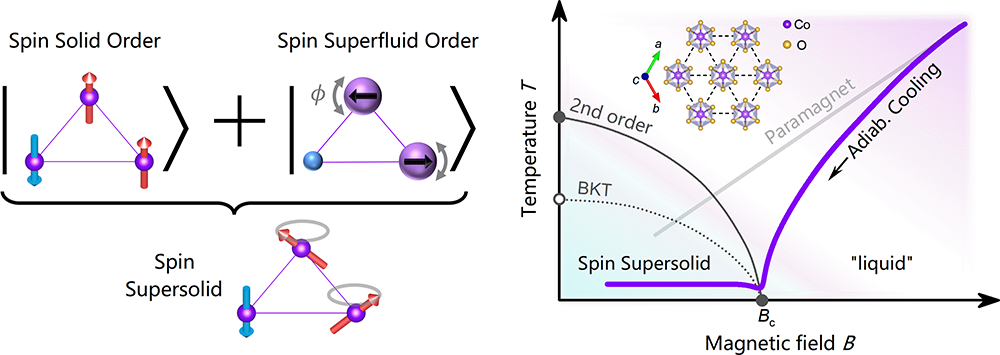Scientists Discover Spin Supersolid and its Giant Magnetocaloric Effect
Date:15-01-2024 Print
Can a solid — a material with a rigid, spatially ordered structure — also be a superfluid that flows with zero viscosity? Theoretical physicist Anthony Leggett posed this question in 1970. An initial observation of such 'supersolid' behaviour in helium-4, made in 2004, was later revealed to be an experimental artefact. Nowadays, except for the simulations with ultra-cold atom gas, such a state remains elusive in solid matters.
Triangular lattice antiferromagnets are highly frustrated quantum spin systems. This feature makes them promising hosts for exotic quantum spin states, including the quantum magnetic analogue of the long-sought-after supersoild state, namely, spin supersolid. In a new study published on January 10 in Nature, a team led by Prof. SU Gang from University of Chinese Academy of Sciences, collaborating with Prof. SUN Peijie from Institute of Physics, Chinese Academy of Sciences, Prof. LI Wei from Institute of Theoretical Physics, Chinese Academy of Sciences and Prof. JIN Wentao from Beihang University, has reported the signatures of spin supersolid state in triangular lattice magnet Na2BaCo(PO4)2 (NBCP). Adding to this, they also discover a giant magnetocaloric effect (MCE) in the spin supersolid phase. This is a property that may pave the way for helium-free cooling to temperatures below 1 kelvin with solid materials.
The researchers measured the temperature variation resulting from changing magnetic field in an adiabatic demagnetization process for high-quality single crystals of NBCP. By mapping out the material's entropy landscape, they revealed two low-temperature regions with pronounced spin fluctuations. To provide microscopic evidence for the coexistence of solid and superfluid spin orderings in these regions, they also conducted neutron diffraction measurements, and compared these results with theoretical calculations made with the intensive density matrix renormalization group technique. This led them to conclude that they had identified a spin supersolid state in a real-world quantum magnet for the first time.
In the adiabatic demagnetization cooling measurements, they observe a lowest temperature of 94 milli-kelvin near the spin-supersolid transition. Such a sharp temperature decrease is caused by the strong spin fluctuations inherent to spin supersolid, and NBCP remains cooled throughout the spin-supersolid phase, in sharp contrast to conventional spin-ordered states. The unique features of NBCP make it a very promising quantum material coolant for sub-Kelvin refrigeration. Unlike conventional dilution refrigeration methods, here the spin supersolid cooling does not require helium — an element that is in short supply globally — so it may find important applications, for example in space detections and quantum technologies, among others.
This study entitled "Giant magnetocaloric effect in spin supersolid candidate Na2BaCo(PO4)2 ", published on Nature, was supported by the National Natural Science Foundation of China, the Chinese Academy of Sciences through the Strategic Priority Research Program, Scientific Instrument Developing Program, and the Project for Young Scientists in Basic Research.

Fig.1 Illustrations of spin supersolid state and its cooling effect near the supersolid–liquid transition in a triangular-lattice magnet (Image by Institute of Physics)
Contact:
University of Chinese Academy of Sciences
SU Gang
Email:gsu@ucas.ac.cn
Key words:
Spin supersolid; magnetocaloric effect; triangular-lattice antiferromagnet
Abstract:
Supersolids are long-sought-after quantum materials with two seemingly contradictory features: rigid solid structure and superfluidity. A triangular-lattice cobaltate material provides evidence for a quantum spin analogue of supersolidity, with an additional giant magnetocaloric effect – discoveries that pave the way for helium-free sub-Kelvin cooling with frustrated quantum magnets.

